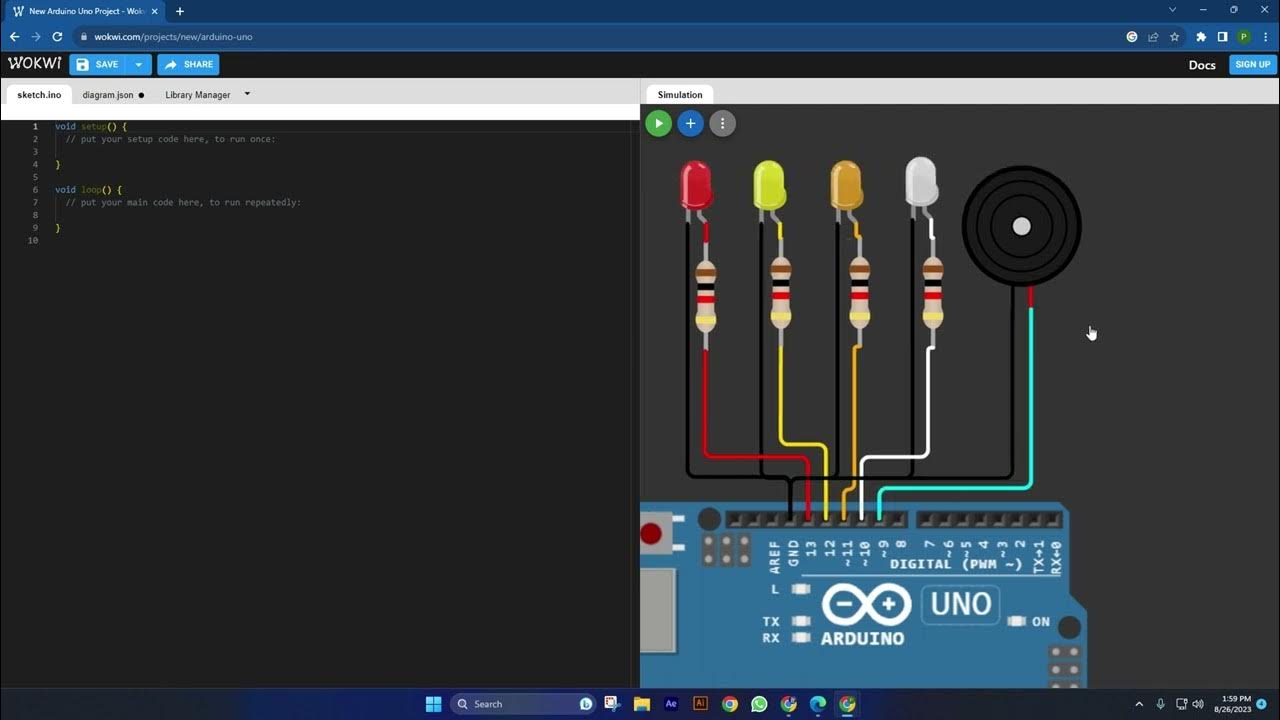Menguasai Alat Penting: Cara Penggunaan Oscilloscope yang Efektif untuk Keperluan Elektronik Anda
Summary
TLDRThis video introduces the basic components and functions of an oscilloscope in the Electronics Laboratory at the Electrical Engineering Department of Universitas Surabaya. It explains how to safely operate the device, covering essential parts such as the display panel, power button, and various control knobs, including focus, intensity, and vertical positioning. The video also discusses signal calibration steps, showing how to connect probes and adjust settings to measure accurate signal voltages and waveforms. By the end, viewers learn how to effectively use and calibrate an oscilloscope for practical applications.
Takeaways
- 👋 The video is an introduction to the Basic Electronics Laboratory at the Electrical Engineering Department, University of Surabaya.
- ⚡ Safety precautions must be followed before conducting experiments to avoid accidents.
- 📊 The oscilloscope’s display panel shows signal graphs, with the Y-axis representing voltage and the X-axis representing time.
- 🔌 The power button is used to turn on the oscilloscope, with the indicator light showing its status.
- 📐 Press Rotation controls the slope of the signal's line on the X-axis, ensuring it is aligned properly.
- 🎯 The focus knob adjusts the sharpness of the frequency line, and the intensity knob adjusts the brightness of the display.
- 🔧 There are two vertical position control knobs for Channel 1 and Channel 2, which adjust how the signal is displayed.
- ⏳ The Fold and Time knobs help set the voltage per division and the time per division, respectively.
- ⚙️ The AC/DC knob selects whether to display only the AC signal or both AC and DC signals.
- ✅ Proper calibration of the oscilloscope is crucial, and it requires setting the signal to match the known calibration voltage of 2V.
Q & A
What is the function of the display panel on an oscilloscope?
-The display panel on an oscilloscope is used to show the graphical representation of the measured signal. It contains the Y-axis for voltage and the X-axis for time, allowing users to observe signal behavior over time.
How does the Y-axis and X-axis on the oscilloscope work?
-The Y-axis on the oscilloscope measures voltage, while the X-axis measures time. The Y-axis consists of 8 divisions, and the X-axis has 10 divisions, helping users analyze the amplitude and frequency of the signal.
What does the power button do on an oscilloscope?
-The power button is used to turn the oscilloscope on or off. When the oscilloscope is powered on, the indicator light next to the button will illuminate.
How do you adjust the tilt of the frequency line on the oscilloscope?
-The tilt of the frequency line can be adjusted using the press rotation knob. By rotating it, the frequency line can be made either more or less inclined relative to the X-axis.
What is the purpose of the focus knob on an oscilloscope?
-The focus knob is used to adjust the sharpness or thickness of the frequency line. Users can make the line clearer or more defined as per their needs.
What does the intensity knob control on an oscilloscope?
-The intensity knob adjusts the brightness of the frequency line on the oscilloscope. Users can increase or decrease the brightness to make the line more visible according to their preferences.
What are the vertical position controls used for?
-The vertical position controls, which include separate knobs for Channel 1 and Channel 2, are used to adjust how the signal is displayed vertically on the screen.
How does the Volt/Div control work on an oscilloscope?
-The Volt/Div control allows users to adjust the voltage scale for each division on the Y-axis. This helps in determining how much voltage each division on the graph represents.
What is the AC/DC switch used for on an oscilloscope?
-The AC/DC switch allows users to select which part of the input signal they want to display. It can show only the AC signal or both AC and DC signals simultaneously.
Why is calibration necessary before using the oscilloscope, and how is it done?
-Calibration is necessary to ensure accurate readings. It involves connecting the probe to Channel 1, setting the oscilloscope to the proper voltage scale, and adjusting the display to show the correct number of divisions that correspond to the known calibration voltage (e.g., 2 volts).
Outlines

Esta sección está disponible solo para usuarios con suscripción. Por favor, mejora tu plan para acceder a esta parte.
Mejorar ahoraMindmap

Esta sección está disponible solo para usuarios con suscripción. Por favor, mejora tu plan para acceder a esta parte.
Mejorar ahoraKeywords

Esta sección está disponible solo para usuarios con suscripción. Por favor, mejora tu plan para acceder a esta parte.
Mejorar ahoraHighlights

Esta sección está disponible solo para usuarios con suscripción. Por favor, mejora tu plan para acceder a esta parte.
Mejorar ahoraTranscripts

Esta sección está disponible solo para usuarios con suscripción. Por favor, mejora tu plan para acceder a esta parte.
Mejorar ahoraVer Más Videos Relacionados

Cara Mengalibrasi (Kalibrasi) Osiloskop Analog - 2122600059

Manejo de Equipos de Laboratorio de Electrónica Pt. 6 (Generador de Funciones y Osciloscopio)

How To Use an Oscilloscope | BEGINNER

DASAR-DASAR ELEKTRONIKA - BAB 2 PRAKARYA SMP/MTS KELAS IX SEMESTER 2

Tutorial WOKWI Belajar Pemrograman Arduino Menyalakan LED dan BUZZER dengan Nilai Anaog

Electronic and Circuits Week 1 Lecturer || Basic Concepts of Electronic Circuit
5.0 / 5 (0 votes)
